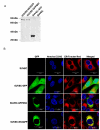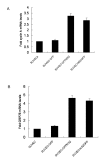Classic swine fever virus NS2 protein leads to the induction of cell cycle arrest at S-phase and endoplasmic reticulum stress
- PMID: 20064240
- PMCID: PMC2819037
- DOI: 10.1186/1743-422X-7-4
Classic swine fever virus NS2 protein leads to the induction of cell cycle arrest at S-phase and endoplasmic reticulum stress
Abstract
Background: Classical swine fever (CSF) caused by virulent strains of Classical swine fever virus (CSFV) is a haemorrhagic disease of pigs, characterized by disseminated intravascular coagulation, thrombocytopoenia and immunosuppression, and the swine endothelial vascular cell is one of the CSFV target cells. In this report, we investigated the previously unknown subcellular localization and function of CSFV NS2 protein by examining its effects on cell growth and cell cycle progression.
Results: Stable swine umbilical vein endothelial cell line (SUVEC) expressing CSFV NS2 were established and showed that the protein localized to the endoplasmic reticulum (ER). Cellular analysis revealed that replication of NS2-expressing cell lines was inhibited by 20-30% due to cell cycle arrest at S-phase. The NS2 protein also induced ER stress and activated the nuclear transcription factor kappa B (NF-kappaB). A significant increase in cyclin A transcriptional levels was observed in NS2-expressing cells but was accompanied by a concomitant increase in the proteasomal degradation of cyclin A protein. Therefore, the induction of cell cycle arrest at S-phase by CSFV NS2 protein is associated with increased turnover of cyclin A protein rather than the down-regulation of cyclin A transcription.
Conclusions: All the data suggest that CSFV NS2 protein modulate the cellular growth and cell cycle progression through inducing the S-phase arrest and provide a cellular environment that is advantageous for viral replication. These findings provide novel information on the function of the poorly characterized CSFV NS2 protein.
Figures






Similar articles
-
Classical swine fever virus NS2 protein promotes interleukin-8 expression and inhibits MG132-induced apoptosis.Virus Genes. 2011 Jun;42(3):355-62. doi: 10.1007/s11262-011-0582-z. Epub 2011 Feb 12. Virus Genes. 2011. PMID: 21318239
-
Classical swine fever virus NS5A protein localizes to endoplasmic reticulum and induces oxidative stress in vascular endothelial cells.Virus Genes. 2012 Oct;45(2):274-82. doi: 10.1007/s11262-012-0773-2. Epub 2012 Jun 21. Virus Genes. 2012. PMID: 22718084
-
Identification of two internal signal peptide sequences: critical for classical swine fever virus non-structural protein 2 to trans-localize to the endoplasmic reticulum.Virol J. 2011 May 18;8:236. doi: 10.1186/1743-422X-8-236. Virol J. 2011. PMID: 21592340 Free PMC article.
-
Approaches to define the viral genetic basis of classical swine fever virus virulence.Virology. 2013 Apr 10;438(2):51-5. doi: 10.1016/j.virol.2013.01.013. Epub 2013 Feb 13. Virology. 2013. PMID: 23415391 Review.
-
Role of innate immunity in pathophysiology of classical swine fever virus infection.Microb Pathog. 2018 Jun;119:248-254. doi: 10.1016/j.micpath.2018.04.020. Epub 2018 Apr 12. Microb Pathog. 2018. PMID: 29655616 Review.
Cited by
-
Enterovirus 71 mediates cell cycle arrest in S phase through non-structural protein 3D.Cell Cycle. 2015;14(3):425-36. doi: 10.4161/15384101.2014.980631. Cell Cycle. 2015. PMID: 25659038 Free PMC article.
-
Apoptosis, Autophagy, and Pyroptosis: Immune Escape Strategies for Persistent Infection and Pathogenesis of Classical Swine Fever Virus.Pathogens. 2019 Nov 16;8(4):239. doi: 10.3390/pathogens8040239. Pathogens. 2019. PMID: 31744077 Free PMC article. Review.
-
Endoplasmic Reticulum Stress Mediated MDRV p10.8 Protein-Induced Cell Cycle Arrest and Apoptosis Through the PERK/eIF2α Pathway.Front Microbiol. 2018 Jun 21;9:1327. doi: 10.3389/fmicb.2018.01327. eCollection 2018. Front Microbiol. 2018. PMID: 29977231 Free PMC article.
-
CSFV Infection Up-Regulates the Unfolded Protein Response to Promote Its Replication.Front Microbiol. 2017 Nov 2;8:2129. doi: 10.3389/fmicb.2017.02129. eCollection 2017. Front Microbiol. 2017. PMID: 29163417 Free PMC article.
-
Classical swine fever virus induces oxidative stress in swine umbilical vein endothelial cells.BMC Vet Res. 2014 Dec 2;10:279. doi: 10.1186/s12917-014-0279-3. BMC Vet Res. 2014. PMID: 25439655 Free PMC article.
References
Publication types
MeSH terms
Substances
LinkOut - more resources
Full Text Sources
Molecular Biology Databases

